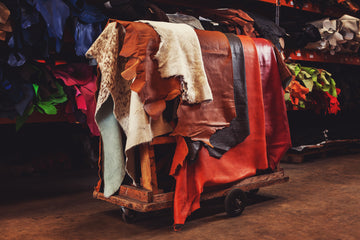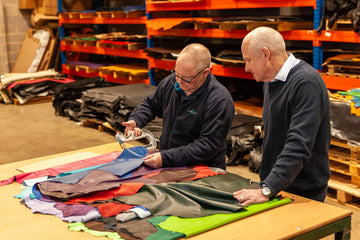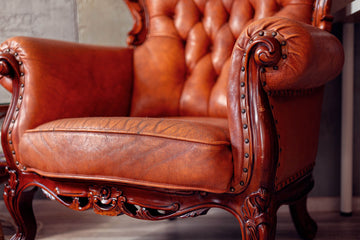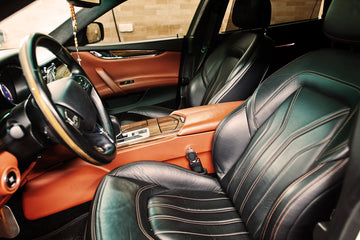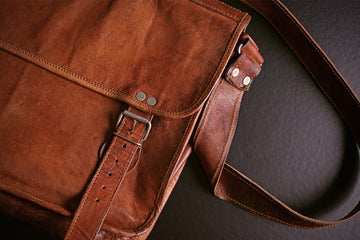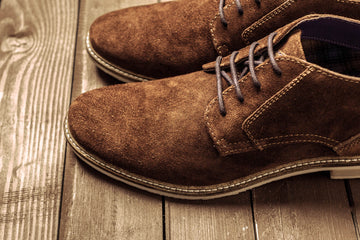Ever wonder if the jacket hanging in your closet is real or synthetic leather? This easy-to-read guide walks you through simple clues — look, feel, smell, and even price — that help you distinguish between the two and shop with confidence.
We'll show you at-home tests, such as the water droplet trick or a quick temperature check, that reveal whether a belt, bag, or sofa is genuine, and also discuss how each material affects the planet so that you can weigh style against sustainability.
We'll also break down the main leather families—bonded, top-grain, and faux—and point out what to watch for so you know exactly what you're bringing home when you browse the shelves or click 'add to cart'.
Key Takeaways
-
Real leather is derived from animal hides, showcasing unique characteristics, natural imperfections, and better durability compared to synthetic alternatives.
-
Synthetic leather is made from artificial materials that mimic the look of real leather but lack the authenticity, ageing qualities, and inherent smell of genuine leather.
-
Key identification tests for differentiating leather types include label checks, water absorption tests, and edge inspections, which highlight the distinct features of real versus synthetic leather.
Understanding Real Leather
Genuine leather, typically made from cowhide, is carefully tanned to maintain its softness and preserve its appearance over time. Because the material breathes, slowly adapts to the shape of your foot or hand, and displays a one-of-a-kind grain, every piece feels and looks different from the next.
Depending on the finish and method, a single hide can be transformed into shoes, bags, furniture, or a car interior, each product assuming its unique personality.
Little nicks, fading patches, and the occasional change in hue that appear as a hide ages only deepen the leather's hype. Artificial options roll off the production line with a flawless, uniform coat that stays the same, yet genuine leather learns to speak, telling its users' story aloud rather than covering it up.
That tie to artistry and the natural world is one reason premier labels seek full-grain skins and why serious fans still hunt items bearing those understated signs.
The ongoing push-and-pull between traditional techniques and modern factories sparks a lively debate; yet, for countless people, genuine animal skin alone qualifies as true leather.
Look a little deeper, and you realise that the charm of real leather has kept it in style for hundreds of years. Because hides come from animals, every piece shows its colour swirls, tiny scars, and natural marks that machines just can't fake. That personal signature gives every bag, jacket, or sofa a character you won't find in mass-produced alternatives.
The touch of real leather adds a second layer of attraction. It's coarse yet supple, warming quickly to the hand, and somehow both rugged and luxurious at once. True leather lovers prize that sensation as much as the look, running their fingers over seams just for the fun of it. Because the material breathes, it allows air to circulate while you wear it, keeping you cooler than many synthetic fabrics.
When it comes to toughness, real leather outlasts almost any artificial option. Scuffs steal nothing but a thin layer, and over the years, a rich patina-a soft, glossy veil-will slowly form, proof that the item has already lived a little. Rather than losing value, well-cared-for leather grows in story and beauty, making every belt or armchair feel like a solid piece of heirloom furniture.
Real leather is prized for its natural smell, a subtle scent that no artificial imitation quite captures. That earthy, sometimes musky aroma adds another layer to the pleasure of owning a genuine leather item. On the other hand, faux leather often emits a sharp, plastic-like odour that many people find unappealing. Due to the scent alone, many opt for real hide over synthetic alternatives.
A wide range of leathers, including full-grain, top-grain, bonded, and more, allows shoppers to select an option that suits their needs and budget. The tough, long-lasting nature of full-grain leather contrasts with the smoother, wallet-friendlier surface of top-grain or bonded hides. By learning how these grades differ, customers can decide what matters most-whether durability, looks, or cost-and buy accordingly.
Full-Grain Leather
Full-grain leather is widely regarded as the best leather available. Crafted from the uppermost layer of an animal hide, it keeps the complete grain pattern intact, meaning no sanding or buffing has been done to hide flaws. Because the protective outer fibres remain, full-grain leather is extremely tough, and as it ages, it develops a rich patina that gives each piece a rugged yet refined look.
That combination of strength and character is why full-grain leather shows up in premium handbags, wallets, and even high-end furniture. Since every hide carries its scars, birthmarks, and tonal shifts, no two items ever look exactly alike; they arrive with a personality and quietly pick up more stories over the years. Its track record proves the adage: quality leather not only lasts but improves the longer you live with it.
Top-Grain Leather
Top-grain leather sits just below full-grain in the quality hierarchy, yet it remains excellent in its own right. Like full-grain, it begins with the outer layer of the hide, but artisans sand away small imperfections, resulting in a smoother, more uniform surface appearance.
This refinishing step makes top-grain softer to the touch and slightly easier to care for, which is why you find it on luxury car interiors, upscale handbags, and modern living-room pieces. While it lacks some of the depth of patina that full-grain develops, top-grain still holds up well over time and looks beautiful without requiring special treatment.
Genuine Leather
The term "genuine leather" often leaves shoppers scratching their heads. For many, it sounds reassuring, yet the phrase can mean very different things to different people. Although it proves the material is indeed from an animal hide, genuine leather typically comes from the lower, less desirable layers of the skin or even leftover pieces glued together. That said, because the foundation is still real cow or goat skin, it can hold up reasonably well if cleaned and stored properly.
You'll find genuine leather showing up wherever makers want the look of leather but keep the price in check. Consider everyday items like belts, wallets, and inexpensive jackets. Just remember that this grade won't age as gracefully or resist wear as well as full-grain or top-grain leather so that it may show scuffs and creases sooner than its pricier cousins.
Exploring Synthetic Leather
Synthetic leather, often referred to as faux leather, is deliberately engineered from artificial materials that mimic the appearance and texture of genuine hide. Commonly used plastics, especially PU (polyurethane) and PVC (polyvinyl chloride), form the backbone of these products, and they tend to be cheaper and far easier to care for than genuine leather.
Its broad colour palette and wide variety of textures mean synthetic leather appeals to both fashion-conscious shoppers and those seeking a vegan option. Still, understanding how faux leather compares to real leather helps buyers select the product that best fits their needs and values.
PU Leather
PU leather, short for polyurethane leather, stands out because it is gentle on the budget and very easy to care for. A quick wipe with soap and water clears most spills, making it suitable for busy lifestyles where everyday messes are a common occurrence. Because it combines good performance with a friendlier price tag, PU leather reaches a much wider circle of shoppers than luxury full-grain hide.
PVC Leather
PVC leather, short for polyvinyl chloride leather, is a widely used synthetic alternative to genuine leather. To create it, makers blend vinyl with several additives that give the surface its feel and colour. The finished product is tough, resistant to abrasion, and often favoured for high-traffic applications like upholstery, luggage, and outdoor gear.
One key selling point is the material's ability to withstand rain, sun, and day-to-day scuffs without noticeable wear. Weather-readiness turns PVC leather into a solid choice for garden furniture, car seats, and any setting where light damage would otherwise ruin the natural hide. Still, critics note that the way PVC is produced and disposed of raises troubling questions for the planet, an issue we will examine further in the future.
Vegan Leather
Vegan leather excludes all animal-derived ingredients, making it an appealing option for shoppers who wish to avoid products linked to animal cruelty. A large share of today's vegan hides still comes from lab-made polymers, yet some brands are now experimenting with plant fibres, pineapple leaves or cactus paddles to lighten the carbon footprint.
The boom in vegan leather aligns with a broader movement towards more compassionate and environmentally friendly shopping habits. Nevertheless, consumers should remember that not every vegan hide product from petroleum or crops needs the same stretch of land, chemicals, or energy as its cow-sourced rival.
Key Differences Between Real and Synthetic Leather
The differences between real and synthetic leather are manifold, affecting:
-
Appearance
-
Texture
-
Smell
-
Durability
-
Price
Real leather has a distinct feel, characterised by small imperfections and a varied grain pattern, whereas faux leather typically appears smooth, even, and sometimes slightly shiny. Because of these basic traits, the contrast between real and pretend leather shows up quickly once you start to touch or look closely at the materials side by side.
Grasping these clues can help you spend your money more wisely. Genuine leather costs more up front, yet usually lasts much longer, grows character over the years, and stands up to daily use in a way most synthetics simply don't. On the other hand, artificial leather is more budget-friendly, easier to clean, and still attractive, although it lacks the warmth and scent that only real hides can provide.
Appearance and Texture
Real leather features:
-
An irregular texture with a natural grain pattern, giving each piece a unique texture and appearance
-
A distinctive pore pattern
-
Wrinkles when pressed, adding to its character
In contrast, synthetic leather has a uniform texture with a consistent pore pattern, often resulting in a rubbery or shiny surface that feels colder to the touch. This uniformity can make synthetic leather appear less authentic and more artificial.
Smell
One of the easiest ways to distinguish leather from other materials is by its scent. Authentic hide emits a rich, earthy musk that people often love. Faux leather, in contrast, can smell sharply chemical or plasticky, and that off-note is almost always the first clue it isn't genuine. In short, the scent of a synthetic piece rarely matches the warm aroma of the real thing.
Durability and Ageing
True leather earns its reputation for toughness because it bends, stretches, and even gets scraped, yet still holds up. Decades of wiping, wearing, and storing usually result in a soft patina that only adds to its charm, a family heirloom kind of charm. Enthusiasts adore that slow, story-like change-the-y body so affordable pieces simply cannot offer.
Synthetic hides are sturdy enough for daily use, yet they spare the telltale journey that real skin enjoys. Instead, they tend to look roughly the same a year later as they do fresh from the store, which is handy in some cases but leaves collectors feeling flat.
Price
The cost gap between real and synthetic leather is considerable. Real leather tends to be pricier due to its superior materials and the skilled craftsmanship required for its manufacture. Choosing genuine leather usually offers greater durability and a longer lifespan, making it a valuable investment for many buyers.
Practical Tests to Identify Leather Types
Differentiating between real leather and synthetic substitutes can be trickier than it seems. Luckily, a few easy checks can help you figure out whether a piece is authentic before you spend your money.
These quick tests come in handy when tags are unclear or missing, or when you simply want peace of mind about what you are buying.
Label Check
Start by reading the label. Phrases such as 'real leather,' 'full grain,' or 'top grain' suggest that you are indeed holding genuine hides. If the wording sounds vague or if the tag has mysteriously vanished, that's usually a sign you should look a little closer.
Many reputable companies are happy to explain their materials, and some even carry third-party seals, such as the Leather Working Group badge, that attest to both quality and environmentally friendly practices.
Leather Water Absorption Test
Another classic test is the water trick. Real hides up moisture and will slowly darken when a few drops land. Simply place one drop on an inconspicuous spot; if it soaks in, you are probably dealing with leather.
Synthetic leather shrugs off water, a giveaway of its artificial origin.
This quick at-home test works well because real leather comes from animal hides, so its natural pores soak up moisture. If you drop a bit of water on the surface, you'll see it darken as the liquid seeps in, and that change sticks around only until the water evaporates. That same porosity makes authentic leather more breathable and comfortable to wear over time. In contrast, synthetic leathers like PU or PVC sit on top of plastics, so water just beads and rolls away.
While that trait makes fake leather much easier to wipe clean, it also means the material can't breathe as freely as the real thing. Although the water test is convenient, leather enthusiasts still recommend pairing it with other checks, such as feeling the grain, inspecting raw edges, and noticing the scent, to determine the type of hide someone has accurately.
Edge Inspection
Examining the edges of a leather item can reveal a great deal about its origin and history. Authentic leather seldom has perfectly neat borders; instead, you can expect a slightly rough, uneven trim that echoes the finish of the original hide. Synthetic alternatives, however, are sliced by a machine, so their edges come out smooth and homogenous, missing that natural texture.
Because of these subtle differences, checking the edges often proves to be a simple and reliable test. Animal hides contain layered fibres that spread in different directions, leaving their jagged profile once they are cut. If you peer underneath, you might even catch a glimpse of those tiny strands or a soft, suede-like underside that something plastic never quite matches.
Artificial leather, by contrast, is rolled out in broad sheets and snipped to size by industrial cutters, which gives it the tidy, straight line that mass-produced goods usually boast. Now and then, an edge will still betray itself with a flash of glossy backing, a clear hint that what you are holding is anything but real.
Environmental Impact of Leather Choices
Increasingly, shoppers are considering the planet's health before deciding whether to purchase leather. Traditional leather making involves a lengthy chain of chemical steps, and each one leaves its mark on air, water, and soil. On the brighter side, hides come mainly from animals raised for meat, so they break down naturally later and at least recycle part of the food system's waste.
Brands that label synthetic leather as 'green' still rarely mention the hidden costs. Many of these knock-offs, made from PU or PVC, require crude-oil feedstock and toxic additives, releasing fumes during both factory production and later landfill disposal. Add in the energy drain, and making large batches often weighs heavier on the climate than curing real hides.
Real Leathers Impact
When people discuss the environmental footprint of real leather, they refer to several interconnected issues at once. True, most hides arrive because cows were slaughtered for beef, so the raw material would have gone to waste if makers did not tan them. Even so, each step, from drinking water to power generation, harms ecosystems, as witnessed by droughts in the cattle belt and rivers tinted blue by chromium after-treatment.
Turning raw animal hides into the leather goods seen in stores involves a series of steps that rely on chemicals, and some of these can harm the planet if not disposed of properly. The work also consumes a significant amount of water and energy, resulting in a substantial overall eco-footprint for the leather industry. Still, many tanneries are moving in a greener direction by relying on vegetable-based tanning and setting up treatment plants that clean the wastewater before it leaves their premises.
Another point in leather's favour is that, because it comes from a real animal, the finished product usually lasts much longer than most synthetic options. That extra toughness means shoes, bags, or jackets sit in closets far longer and don't need to be replaced as often, which can trim the amount of waste sent to dumps over time. What's more, once a leather item is finally worn out, it will break down in a landfill over time, while plastic-fibre goods can linger for decades or longer without fading at all.
Synthetic Leather's Impact
Whipping up synthetic leather at an industrial scale is a surprisingly messy gig. You run into some seriously harsh chemicals along the way, and the sludge that piles up after production has nowhere good to go. That leftover gunk makes me uneasy because it eventually filters into the soil and waterways we count on. A handful of brands are pursuing greener methods, yet the majority of fake leather still relies on oil-based plastics that never truly disappear from the Earth.
Materials like polyurethane and PVC require energy-intensive machines that emit additional carbon into the atmosphere during operation. And here is the rough part: when that shiny faux-leather bag or trendy shoes finally give out, pitching them only creates another problem. Bits of plastic linger in landfills for decades, breaking into micro-sized specks that drift into rivers and the ocean, where living things mistake them for food.
The good news is that brands are finally paying attention to the concerns about leather and plastic in the fashion industry. I've started spotting some exciting substitutes on store shelves. Creative makers now turn pineapple scraps, cactus pads, and even leftover mushroom bits into soft, leather-like materials. The goal is simple: use way less oil, and still make something that breaks down naturally when you're done with it. The trick is that these plant options are still relatively new to the market, so they cost more and sometimes don't hold up as well as the tried-and-true synthetics.
That leaves shoppers stuck between choices. Real leather eventually rots away and typically comes from animals raised for meat. On the other hand, most faux-leather products save animals, but are still made from plastic that will sit in a landfill for decades. When you delve into the numbers and see how each option utilises water, power, and waste, it becomes easier to make smarter purchases and feel a little less guilty about what's in your closet.
Summary
To sum it up, understanding the differences between real leather and synthetic leather helps you shop more intelligently and confidently. Real leather feels unique, wears in over time, and carries a story many fans love-nothing quite like the scent after years of use. On the other hand, fake leather is usually more wallet-friendly, easy to clean, and, with vegan options emerging, offers a guilt-free look that still turns heads.
Weighing looks, feel, smell, lifespan, and how each affects the planet allows you to choose the kind of leather that matches your style and values. Whether you lean toward genuine heritage, budget-friendly flair, or eco-friendly living, having these facts in mind helps steer you toward the best bag, jacket, or pair of shoes for you.
